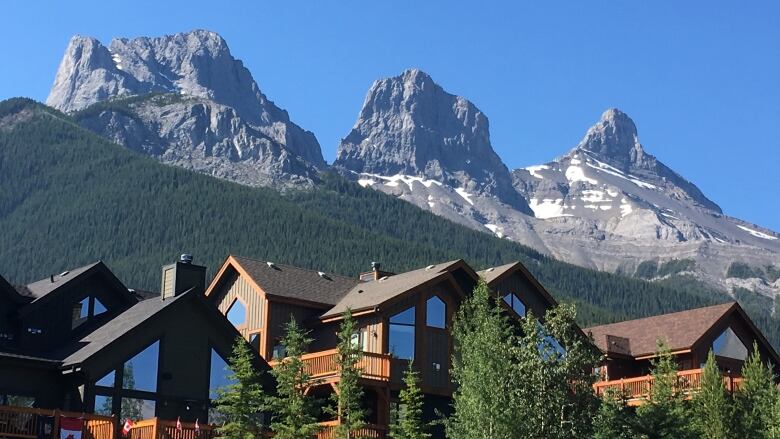OPINION | For the love of Canmore: A proposed development threatens to upset the balance
A tricky interplay exists in the Bow Valley between urban development and ecological integrity

This column is an opinion fromRobin Pollard,a University of Victoria student and Canmore resident.

Growing up in the mountain town of Canmore is what many would call a dream; but that's all it is at the moment.
Currently, Canmore is grappling with proposals from Three Sisters Mountain Village (TSMV) which could double Canmore's population and threaten Canmore's affordable housing, economy, wildlife, and climate change commitments.
As a university student, it is difficult to imagine a future in which I can afford to live in the community where I was born and raised. The pursuit of second homes has driven rental and housing prices out of reach for much of the community resulting in an estimated 30 per cent of Canmore's houses sitting empty and making Canmore the least affordable place to live in Alberta.
Unfortunately, the proposed TSMV developments are unlikely to change these disheartening dynamics. Just 10 per cent of the new units to be built over a 30-year period are affordable housing units, according to their plans.
We need a new approach if we want to avoid the fate of similar towns with similar pressures.
Canmore declared a climate emergency in 2019. The town's Climate Action Plan clearly sets out Canmore's goal to reduce greenhouse gas emissions by 80 per cent of 2015 levels by the year 2050. Yet TSMV's proposal includes car-dependent neighborhoods and requires that underground hazards left over from Canmore's coal mining days be filled with concrete the production of which, on a global scale, creates more emissions than all of Canada.
Crucial wildlife corridor
Given the rugged mountains of the Bow Valley, the majority of Canmore's economy is adventure tourism based, and wildlife-human encounters are becoming dangerously common.
The Bow Valley is a crucial wildlife corridor one of just four east-west connections in the entire 3,200 km Yellowstone-to-Yukon region. It is increasingly difficult for large mammals to navigate this narrow valley due to an ever-expanding human footprint, and these proposed developments put habitat and linkage zones for wildlife in jeopardy. Consequently, wildlife is pushed onto steeper slopes where vegetation is sparse and recreation use remains high.
According to ecologists, plans that coulddouble Canmore's population and put up to 14,500 people right up against an already compromised wildlife corridor poses a major threat to the connectivity of keystone species, such as grizzly bears and wolves. Even if the town could support an additional 14,500 people, building houses right beside the corridor will undoubtedly have a negative impact on this sensitive and crucial area.

Canmore is at a crossroads, with many citizens recognizing that without strong and informed municipal leadership, the future of the town could rest in the hands of a single developer. Despite a growing wave of citizen opposition, the town council passed the first reading of TSMV's Area Structure Plans (ASPs) on February 9. Consequently, frustration is rising among citizens who feel like their voices aren't being heard.
Indeed, a tricky interplay exists in the Bow Valley between urban development and ecological integrity. The importance of negotiating a creative solution that benefits both people and wildlife in this dynamic place, while centring community engagement cannot be overlooked.
Understanding the threats posed to Canmore's affordable housing, economy, wildlife and climate change commitments are integral to grappling with the complexity of this issue moving forward.
People with knowledge and energy, who are equipped to create innovative solutions, have already come forward in response to TSMV's proposed developments. Needless to say, the community is passionate about making the right decision.
Collaboration needed
Moving forward, a collaborative approach could include focusing on community interests instead of positional outcomes a position is what a party wants or thinks they want, and an interest is the "why" behind the position. We have the opportunity to reach a mutually acceptable interest-based outcome by stepping back and having community conversations about Canmore's future.
I encourage the town to start a formal process to generate a community vision that centres the climate crisis, sustaining viable wildlife populations, and socio-economic values. This framework could function as a baseline for future development proposals and must include cumulative environmental impact assessments, which TSMV's plans do not include.
In the meantime, the town has the regulatory power to reject the current ASPs until a community focused solution is established. The town is holding a virtual public hearing on the development proposal on March 9.
The beautiful Bow Valley is likely one of the most developed areas in the world where grizzly bears still exist, so to say that we are at a tipping point is an understatement. The proposals put forth by TSMV do not align with the future we need to work towards a future that maintains a balance between wildlife, ecological integrity and the Canmore community.
This column is an opinion. For more information about our commentary section, please readour FAQ.
Clarifications
- An earlier version of this column stated that the new development "would" double Canmore's population. In fact, the Town of Canmore's website says it "could" double the population.Mar 04, 2021 4:43 PM MT
- While the TSMV proposal includes a 10 per cent commitment to create perpetually affordable housing, the developers say they are using a variety of tools to make a 20 per cent commitment to affordable housing throughout the development. This includes commitments to build a minimum of 350 employee housing beds and a minimum of 200 market rental units within Three Sisters Mountain Village - which the company says will be affordable housing - and the provision of 2.32 hectares of land to the Town of Canmore for the purpose of affordable housing that could accommodate 100-200 affordable housing units in the future.Mar 05, 2021 11:12 AM MT












_(720p).jpg)


 OFFICIAL HD MUSIC VIDEO.jpg)
.jpg)



























































































